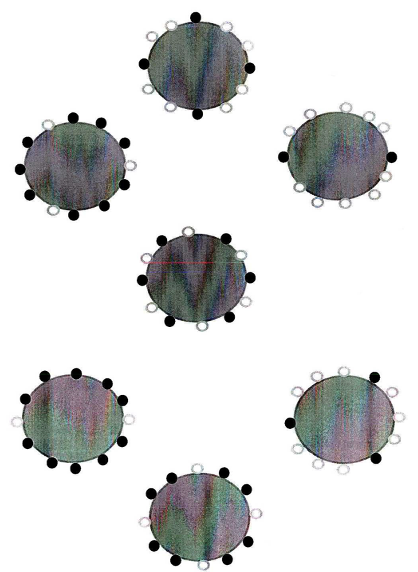6 Cell Washers Information and Troubleshooting

Operating Conditions
- Must sit on hard level surface with no vibrations
- Needs a “drain” hose (not kinked and so gravity will let supernatant flow down and out)
- Use only glass tubes
- Must be plugged into the unit then into the plug
- Needs to be balanced
- The “check” button can be used to interrupt after a saline fill to check the volume of saline in each tube
- Priming is required when a new box of saline is installed
Operation Definitions
Wash Cycle: The process of filling tubes with saline, spinning to concentrate sample, decanting the saline leaving a “button” of sample in the tube bottom. In multiple cycles after decant an agitation step in included.
Decant: Holding the tubes at a slight negative angle and spinning at slow speed to push saline up the sides and out of the tubes.
Agitate: A process of quickly stepping the motor/rotor to shake and break up the “button” or cell pellet to suspend the sample for the next wash cycle.
The cell washer is programmable to perform up to four 80-second wash cycles. The system automatically eliminates the “agitate” step from a single, or, the final wash cycle so that a clean pellet is present at the completion of the run.
Each wash cycle consists of four steps:
- FILL: Low Speed: saline is drawn from the box by the peristaltic pump up through the flow control valve, the flow switch and the cover saline dispensing nozzle. The nozzle feeds the saline into the inlet porthole in the rotor distributor where the filler tubes feed the saline into the test tubes.
- SPIN: High Speed: The system rapidly accelerates to full speed to pellet the red blood cells. Dynamic braking at the end of this step provides rapid deceleration to prevent re-suspension or dislodging of the cell button.
- DECANT: Low Speed: The decant function of the cell washer involves three elements. The rotor, solenoid plunger and solenoid coil. The solenoid plunger (located beneath the rotor) has a metal band on it which, when the solenoid coil is energized, is pushed upward, locking the bottom tabs of the tube holders at a negative angle. Then, when the rotor is spun at low speed, the saline is forced up the sides of the tubes and out by low centrifugal force. This action retains virtually all cells in the tubes while removing almost all residual saline. Decanted waste solution is directed, by the splash guard in the cover, into the drain-hole in the chamber and into the drain tubing which carries the waste out of the cell washer and into a waste container or drain.
Several factors can prevent proper decanting:- Saline build up in the solenoid plunger well and/or on the motor shaft
- Corroded or dirty solenoid plunger.
- Broken tube holder tabs on rotor.
- Defective solenoid coil.
- PC board.
- AGITATE (except in a single or final wash cycle): This phase is included on all but the final, or a single, wash cycle. By a rapid “stepping” motion of the rotor, cell pellets are disrupted (broken up) for re-suspension of the cells during subsequent wash cycles.
Troubleshooting Cell Washers
The number one cause of decanting problems is cleanliness; saline (crystals) can build up in the rotor blocking the decant holes resulting in tubes not evenly filled, poor washing, therefore failure of control cells(.CC’s) . Soak the plunger/rotor in warm soapy water or rinse the top of the rotor with warm water then place empty tubes in the rotor. Begin an automatic wash cycle and press check after beginning the run. At the end of the fill step the cell washer will stop. Examine the level of saline in the tubes. Fill is considered acceptable if the level of saline in the highest tube fill is between 5 and 8 mm from the top of the tube and the difference between the highest fill tube and the lowest fill tube is not more than 10 mm.
Maintenance
- Calibrate saline volume. Should be 40 mls for 10X75 (we use these) tubes and 54 mls for 12X75 tubes. If the volume delivered is below the required amount adjust the saline flow valve (clockwise to decrease the amount of saline and counterclockwise to increase the flow).
- To check individual tube volumes: Begin an automatic wash cycle, after the run begins press check. At the end of the fill step the cell washer will stop. Examine the level of saline in the tube. Fill is considered acceptable if the level of saline in the highest tube fill is between 5 and 8 mm from the top of the tube and the difference between the highest fill tube and the lowest fill tube is not more than 10 mm.
- Weekly: flush dilute (1/10) bleach for 4 wash cycles. Remove tube from saline, purge using the calibrate button. Place tube into dilute bleach and run for 4 wash cycles. Remove tube from bleach and purge by using the calibrate button. Place tube into distilled water and run for 4 wash cycles to rinse. Remove tube from the distilled water and purge using the calibrate button. Place tube back onto saline box and prime using the calibrate button. Calibrate to insure saline levels are ok.
- Clean the rotor using warm water directed through into the hole in the top of the rotor for several minutes. Make sure water is flowing freely out of all filler tubes (no residual salt precipitate clogging filler tubes). Install and spin rotor for 20 seconds to remove excess water.
